If you’re shopping for a diamond engagement ring and see the price tag, you may wonder, are diamonds rare? Why do they cost so much? Is demand only driven by advertising? Do they have intrinsic value? We look at these questions and more.
(more…)
If you’re shopping for a diamond engagement ring and see the price tag, you may wonder, are diamonds rare? Why do they cost so much? Is demand only driven by advertising? Do they have intrinsic value? We look at these questions and more.
(more…)
The three stone engagement ring is a classic style, and now that the Duchess of Sussex, Meghan Markle, is wearing one, it’s a popular choice. What does it symbolize? Which diamond shapes work best? Follow these tips to pick a beautiful one.
In this blog, we cover:
What’s the meaning of a three stone engagement ring?
What has more sparkle: a diamond solitaire or a three stone engagement ring?
Which diamond shapes work best for a three stone engagement ring?
Diamonds are popular side stones in a three stone engagement ring
Colored stones can be side stones in a three stone engagement ring
What mountings work best for a three stone engagement ring?
A three stone engagement ring typically has one center diamond bordered on each side by another gem of the same size or smaller. The three stone engagement ring style dates back at least to the 17th century, and it is rich in meaning. To some, the three stones represent a love that encompasses “yesterday, today and tomorrow.” To others, they symbolize “friendship, love and fidelity” or “mother, father and child.” Others believe the three stone engagement ring represents the Holy Trinity. In some designs, the center stone is a colored gem, but here we will focus on three stone engagement rings with a diamond at the center.

A treasure from the Victorian era (1837-1901), this three stone engagement ring is set with old mine cut diamonds in 18K gold. Courtesy: DoyleDoyle.com
Cut, one of the 4Cs of diamond quality (the other three are Color, Clarity and Carat Weight), is an important factor in how much a diamond sparkles – diamond experts call that ‘scintillation.’ The GIA cut grade takes into account the diamond’s proportions, culet size and girdle thickness, as well as the symmetry of its facet arrangement and the quality of the polish on those facets. Facets are like tiny mirrors. Their size and placement will influence how light behaves as it passes through the diamond and back to your eye.

A diamond solitaire in a six-prong setting is a classic engagement ring. Courtesy: JK & Co. Jewelers
GIA only grades the cut of round brilliant diamonds; other diamond shapes do not receive cut grades. A round brilliant’s potential cut grade ranges from Excellent to Poor. You can take a deep dive into understanding diamond cut by reading GIA Diamond Cut Grade: Six Things You Need to Know. A GIA Diamond Grading Report can tell you a round brilliant’s cut grade, giving you objective information you need to make a comparison. Learn more about comparing loose diamonds by reading our blog.
Assuming in both cases the diamonds are of equal size and quality, a three-stone diamond engagement ring will have more sparkle than a diamond solitaire. But what if you’re comparing diamonds with different cut grades? Or you’re comparing diamonds that are not round brilliants? Or for the same price as the three stones you can get a solitaire that is significantly larger? If sparkle is what you’re looking for when comparing diamonds of different shapes, cut grades or sizes, view the solitaire and the three stone rings under different lighting environments – and not just under the bright lights of the store.

A trio of oval diamonds creates a mesmerizing piece. The center diamond weighs 1.70 carat (ct) and the two side stones total 0.78 carats. Courtesy: EraGem.com
Since the round brilliant is the most popular diamond shape, it’s no surprise that you’ll see many three stone engagement rings set with round brilliants. Other popular diamond shapes for three stone engagement rings are the oval and the square or rectangular princess cut and cushion cut. An engagement ring with one large and two smaller emerald cuts has a sleek, sophisticated look. The symmetry of this shape brings a grace and rhythm to the ring.
You can also mix and match shapes. For example, a trilliant cut diamond on either side of a marquise, oval or princess cut diamond would frame the center stone nicely.

Mixing diamonds of different shapes and colors can create an unforgettable piece. This ring has a 3.03 ct fancy yellow cushion cut diamond bookended by 0.54 carats of half-moon cut diamonds. Platinum, yellow gold and rose gold are artfully used to create more visual richness. Courtesy: Novel Collection
Many three stone engagement rings feature a prominent center diamond flanked by two smaller side stones. To create a harmonious look, jewelry designers and manufacturers often pick side stones that have color grades identical or close to the grade of the center diamond. GIA organizes diamond color into five groups:
You can use this information when searching for side stones to complete your three stone engagement ring. Diamond Color: Seven Things You Need to Know gets to the heart of diamond color.
Clarity grades should also be similar but need not be identical, as most inclusions are not visible with the unaided eye unless the diamond has a grade of Included (I1, I2 or I3). Learn more in Seven Things You Need to Know About Diamond Clarity and VVS versus VS Diamond: What’s the Difference in Diamond Clarity?
Want to add a pop of color to your three stone engagement ring? Then consider adding rubies or sapphires as side stones. Both gems are cherished for their beauty. They are also a 9 on the Mohs scale of hardness, making them durable, long-lasting choices for an engagement ring (only a diamond is harder). You can use colored gems as the center stone of your ring. Here are tips for picking a stunning ruby or sapphire. You also have other choices for colored gemstones, and we share them in our Buying Guide: Colored Gemstone Engagement Rings.

A 1.39 ct round brilliant cut diamond is framed by two round rubies weighing 1.41 ct and 1.37 ct. Courtesy: 1stdibs.com

Two sapphires are a tranquil evening sky against which the center diamond glitters like a bright star. Courtesy: Omi Privé
Deciding how to set the stones in a three stone engagement ring is a matter of personal preference and your beloved’s lifestyle. The most common choices are prong and bezel settings.
A prong is a narrow metal support, usually in groups of four to six, used to hold a gemstone securely in place. A bezel is a thin metal strip that is pushed or hammered around the edges of a gem to hold it in place. Prongs will show off the diamond better, as the least amount of metal will be on the stone. Less metal means more diamond to see and admire. The trade-off is that diamonds in a prong setting can be more vulnerable to damage than those in a bezel setting. Because a bezel setting protects the stone, it is an excellent choice for individuals who are physically active and love the outdoors.

In this engagement ring, prongs hold the three diamonds in place. Courtesy: 1stdibs.com
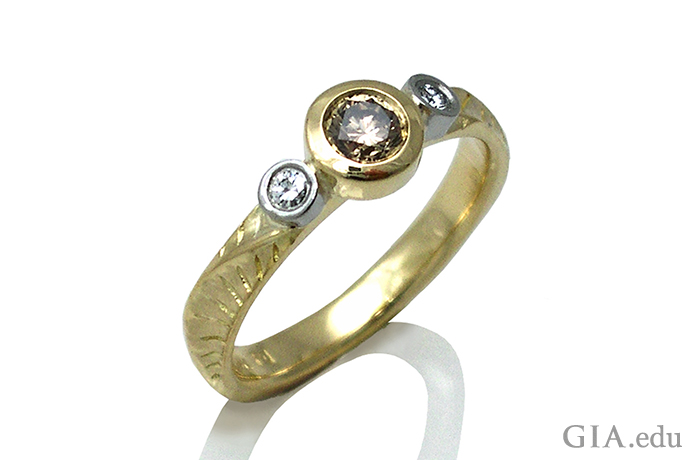
Play ball! Or go hiking, rock climbing or whatever your favorite sport. The center 0.25 ct brown diamond and 0.07 carats of colorless side diamonds are secure in their bezel settings. Courtesy: K. Mita Design
The three stone engagement ring has charmed for centuries – and is now especially chic. Pick a beautiful one, and you’ll have an engagement ring that is timeless.
The three stone engagement ring is hot, and so are these seven other irresistible Engagement Ring Styles.
“Will you marry me?” It’s the ultimate question. You want the marriage proposal to be perfect and the answer to be “yes!” There’s a lot that goes into popping the question. But have no fear. Follow these common tips for how to propose in a few simple steps. (more…)
A cruise ship vacation offers a sea of buying options for diamond or colored gemstone jewelry. To get the best value for your memento, it pays to do some homework and know the risks of buying jewelry while on a cruise. (more…)
Many jewelers offer a way to create your own engagement ring featuring the use of semi mount rings. These partially set mountings let you create an engagement ring that is uniquely yours, often more quickly and for less money than a custom engagement ring. (more…)
Ready to propose but not ready to buy an engagement ring? A placeholder ring is a great stand-in while you work out the thousand-and-one details that go into buying your forever engagement ring. Here’s what to consider: (more…)
Diamond stud earrings can dress up your look. They add a splash of style to any outfit. And turn heads. Just ask trendsetter Meghan Markle, now the Duchess of Sussex. Here’s how to choose a pair of diamond studs you’ll love. (more…)
If you’re shopping for an engagement ring, you need to know about carat weight – the measurement of how much a diamond weighs. Carat weight is important because it helps determine a diamond’s price and reflects its rarity. We take a closer look. (more…)
Gold engagement rings are forever favorites. But how do you pick the right color gold for your ring style and center diamond? Here’s a quick breakdown on gold alloys and what to consider when making this important engagement ring decision. (more…)
A GIA diamond cut grade is key to knowing how well your round brilliant diamond will sparkle. Cut is the most complex of a diamond’s 4Cs. Let’s cover some essentials so you can pick the perfect round brilliant diamond engagement ring.
In this blog, we cover:
The most popular diamond in the marketplace is the round brilliant. Experts estimate that this cut alone accounts for more than 70% of all diamonds sold today. The quality of a round brilliant diamond’s cut determines how much the diamond sparkles. To pick a diamond whose flashes of light enchant the eye, you need to know the 4Cs of diamond quality, the universal standard for judging diamonds: color, cut, clarity and carat weight. All else being equal, the better the cut grade, the more valuable the diamond.
Some professionals consider cut the most important C of diamond quality. A well-cut round brilliant delivers that unmistakable, stop-in-your-tracks light show that telegraphs “diamond” across a crowded room. If the diamond is well cut, most compromises in clarity, color and even carat weight can be forgiven. A diamond’s cut grade is also an indication of how well it was designed and crafted. So, understanding the diamond cut grade is key to picking a round brilliant that’s not only beautiful, but also the best value.
In arriving at its cut grading system, GIA spent 15 years studying how light behaves within a round brilliant cut diamond. GIA’s aim was to understand the factors that contribute to a round brilliant’s appearance and to determine which of those factors – or combination of factors – produce diamonds that people consider attractive.
GIA’s research included the use of advanced computer modeling to analyze tens of thousands of possible proportion combinations. GIA then validated its research with human subjects, conducting more than 70,000 observations on actual diamonds, to determine which diamonds people found appealing and why.
The result was the GIA Cut Grading System, which evaluates the cut quality of a round brilliant diamond along a five-point scale ranging from Excellent to Poor.
A GIA cut grade evaluates:
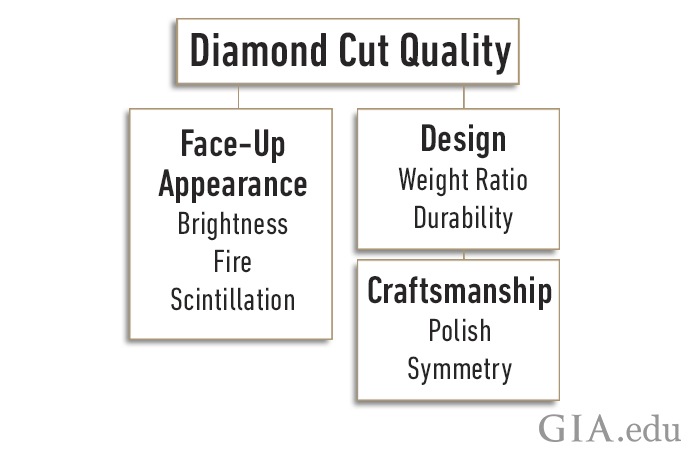
The GIA diamond cut grade is based on seven factors: brightness, fire, scintillation, weight ratio, durability, polish and symmetry.
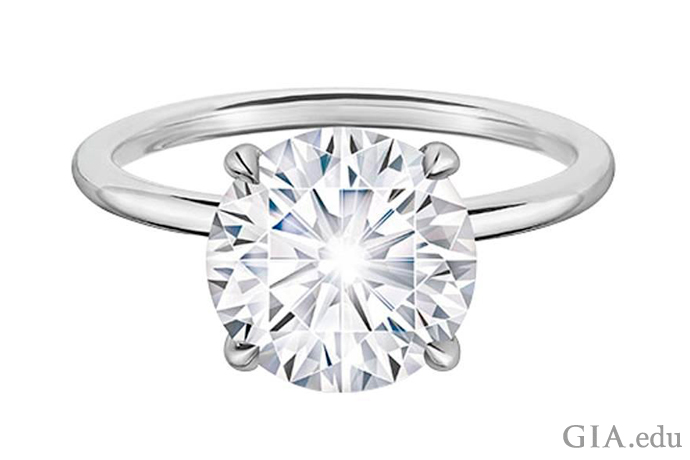
This 2.02 carat (ct) round brilliant has excellent cut, polish and symmetry. Courtesy: 1stdibs.com
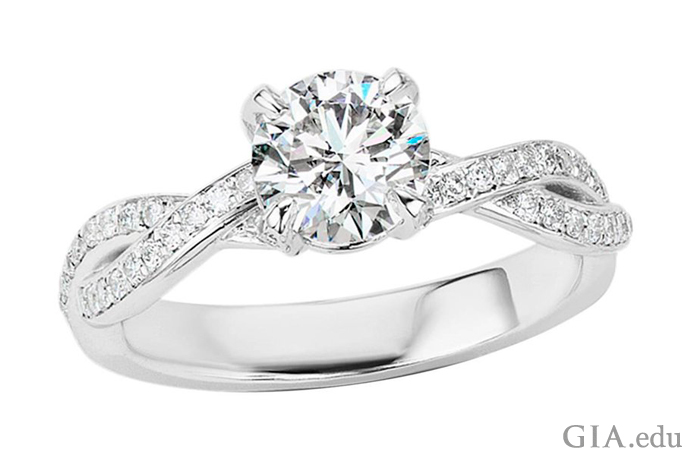
The reason behind the sparkle of this 1.01 ct round brilliant cut diamond engagement ring is the quality of the diamond’s cut. The diamond received an Excellent cut grade from GIA. Courtesy: 1stdibs.com
A key component of a GIA diamond cut grade is the diamond’s face-up appearance – or how the diamond looks when viewed from above, as if it was set in an engagement ring. People love diamonds for their dazzling interplay with light – which the layperson often translates as “sparkle.” But there’s a lot more going on here.
When you see internal and external white light reflected from a diamond, you’re noticing “brightness.” If you see the scattering of light into all the colors of the rainbow, you’re being treated to “fire.” Sparkle is actually “scintillation,” the pattern of bright and dark areas caused by reflections within the diamond as it or the light source moves. What you might consider “sparkle” is really the overall visual effect of these three factors. A GIA cut grade includes an assessment of how well a diamond delivers on each of these attributes.
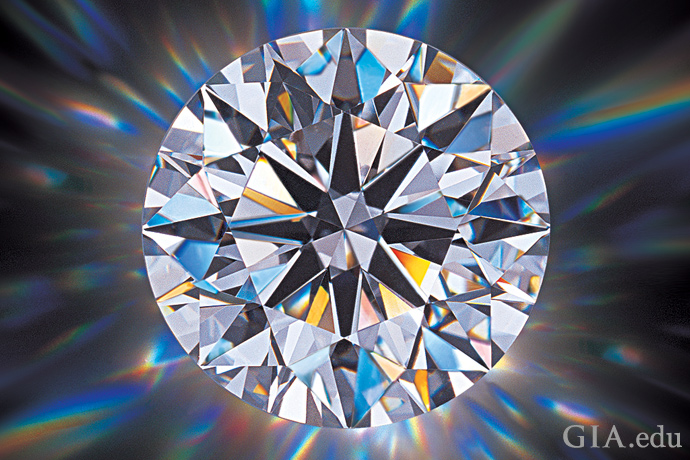
This round brilliant cut diamond shows good brightness and fire. Scintillation, the pattern of light and dark areas and the flashes of light, or sparkle, can only be seen when a diamond is moved. Copyright: GIA & Harold and Erica Van Pelt
A diamond’s proportions – its crown and pavilion angles and the relative measurements of its facets – are key contributors to a diamond’s overall face-up appearance. Remember that facets are tiny mirrors. Their size and placement will influence how light behaves as it passes through the diamond and back to your eye.
A diamond’s proportions can help predict how well a diamond will deliver brightness, fire and scintillation. However, an important outcome of GIA’s cut research was the finding that there is no single set of proportions that defines a well-cut round brilliant diamond. In fact, diamonds with different proportions can receive the same cut grade. The diamonds may look and perform differently but they will still have a similar impact on the observer. So, as a diamond shopper, you need to look beyond the measurements on a grading report. Be sure to view a diamond in person to see if it’s the right choice for you.
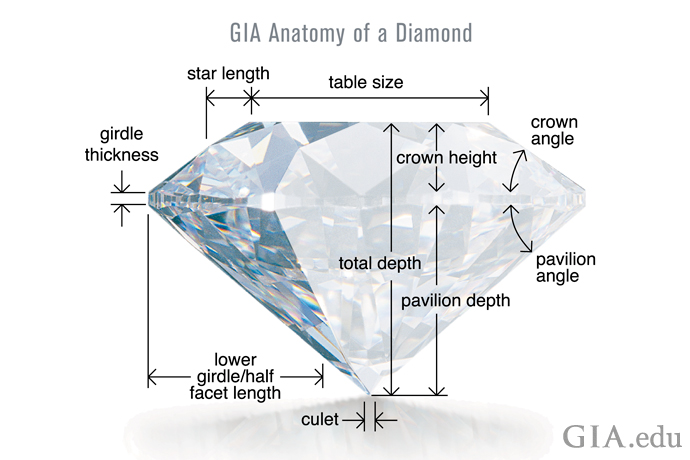
This graphic illustrates the proportions that affect a diamond’s cut grade. The crown and pavilion angles and the relative measurements of its facets contribute to a diamond’s brightness, fire and scintillation.
While face-up appearance is all about how a diamond looks, design and craftsmanship evaluate the quality of the diamond’s manufacture. Poor design could add unnecessary weight to a diamond or cause durability issues that would prevent you from enjoying it for a lifetime. A diamond with poor craftsmanship won’t deliver much in the way of brightness, fire and scintillation. In evaluating these two components, the GIA Cut Grading System takes into account the diamond’s physical shape, its proportions, its weight ratio, and the care that went into fashioning and polishing its facets.
Design
Design refers to decisions made during the fashioning process that determine the diamond’s physical shape, as seen in its proportions, weight ratio and durability. Weight ratio is the diamond’s weight in relation to its average girdle diameter (a fairly complex mathematical equation). A diamond with a smaller girdle diameter relative to its weight might appear smaller face-up than its well-designed counterpart, because much of the weight would be “hidden” in the overall depth of the diamond. For example, while a diamond with a thicker girdle could look great, the girdle is hiding unnecessary weight. As a result, you might end up paying more for a heavier diamond with no greater visual impact for the added cost. The bottom line: A diamond should not weigh more than its face-up size would indicate.
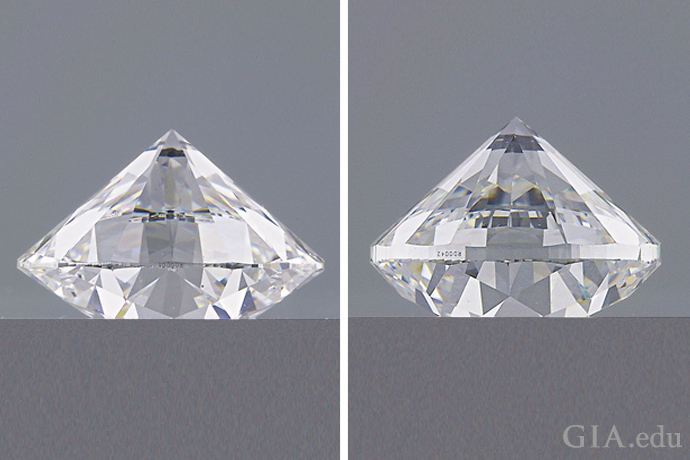
These pictures show the importance of weight ratio. Both of these diamonds have the same average girdle diameters, so face-up they appear to be the same size. But the diamond on the right has a much thicker girdle, so it weighs more (0.71 ct vs. 0.61 ct). The thicker girdle has no visual benefit, but the added weight will make the diamond more expensive. Photos: Maha Tannous/GIA
Durability in the case of a round brilliant diamond refers to the risk of damage that might result from an extremely thin girdle. Such a girdle can make a diamond highly vulnerable to damage during the jewelry setting procedure or even normal wear. Considering how much a diamond costs and its emotional significance, you want to avoid one that is susceptible to damage. A GIA Diamond Grading Report can eliminate this concern.
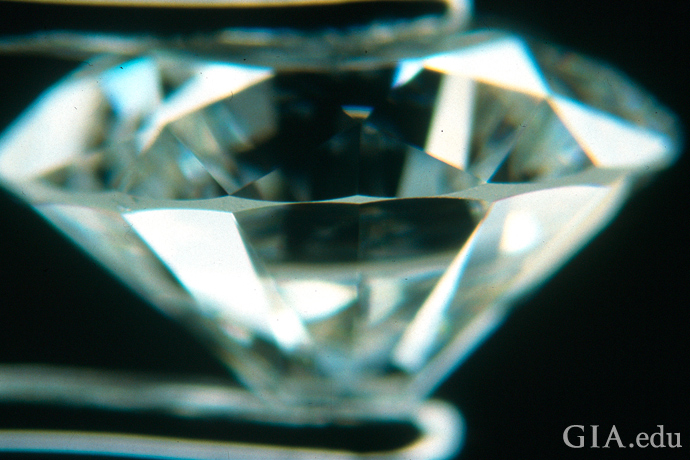
Here is an example of why durability is important. This 1.35 ct diamond has girdle areas that are very thin to extremely thin, making it more susceptible to damage during everyday wear. Courtesy: Gary Roskin, G.G., F.G.A.
Craftsmanship
Craftsmanship describes the care that went into fashioning the diamond, as seen in its polish and symmetry. Polish refers to the overall quality and condition of the facet surfaces. It includes evaluation of any blemishes created by the polishing process or during wear. Polish is critical to the mirror-like performance of a diamond’s facets.

The diamond on the left shows lines created during the polishing process. The diamond on the right has abraded facet junctions caused by wear. Polish lines and abraded facet junctions can also affect a diamond’s clarity grade. Photos: Mitchell Moore/GIA
Symmetry is the exactness of a finished diamond’s shape and the arrangement and placement of its facets. A symmetrical diamond has an even display of brightness, fire and scintillation. A diamond with poor symmetry will have poor light performance, meaning that it’s likely to look flat.

All eight sections of a round brilliant cut diamond should be identical. This symmetry will help produce even brightness, fire and scintillation. Illustration: GIA
GIA evaluates a round brilliant diamond’s cut based on seven components – brightness, fire, scintillation, weight ratio, durability, polish and symmetry – to arrive at a GIA diamond cut grade, which ranges from Excellent to Poor. The grade is set by the lowest assessment the diamond receives for five of the seven components. In other words, if a diamond receives a Poor grade for brightness, then the highest its overall cut grade can be is Poor. The exceptions are polish and symmetry, which are assessed using standard GIA grading methodology: A diamond with Very Good polish and/or symmetry, for example, may receive an Excellent cut grade.
A GIA Diamond Grading Report contains the diamond’s full cut assessment, in addition to a diagram showing the diamond’s proportions and relative measurements. Consider the report an invaluable tool in helping you pick a dazzling diamond.
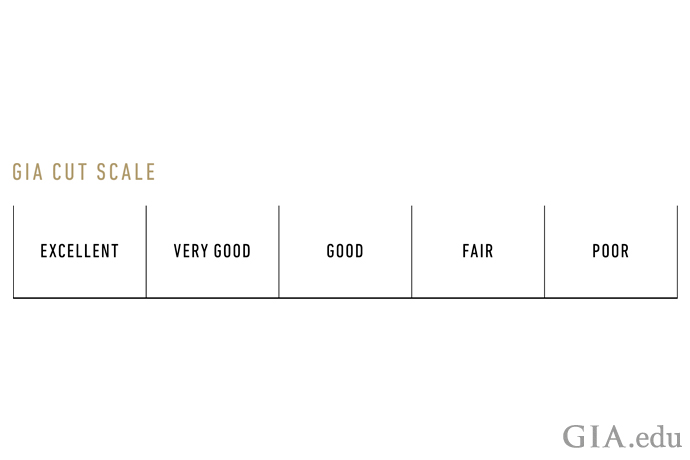
The official GIA Cut Scale for round brilliant cut diamonds. Illustration: GIA
While knowing a diamond’s cut grade is essential, it shouldn’t be a substitute for seeing a diamond in person. As mentioned above, a diamond cut grade represents a range. For example, two diamonds with an Excellent Cut Grade may look – and perform – very differently. In addition, a diamond will look different under various lighting conditions, so you should take it for a test drive, so to speak. Last, you need to fall in love with the diamond – and no report can substitute for what stirs your heart.

An Excellent cut grade makes this 2.03 ct round brilliant diamond mesmerizing. Courtesy: 1stdibs.com
Diamond cut is extremely important. So is diamond color. Learn about it, too, so you can pick a spellbinding diamond.
Diamond clarity is the relative absence of inclusions and blemishes. You should know about this 4Cs quality factor because it affects a diamond’s beauty and value. To understand what a diamond clarity is, use these tips to help you shop smartly:
Diamond clarity is one of the 4Cs (the others being color, cut and carat weight). It plays an important role in determining a diamond’s overall beauty and ultimately its value. Diamond clarity refers to inclusions in the diamond and blemishes on its surface.
Inclusions and blemishes can result from a diamond’s formation, its crystal structure, the cutting-polishing-setting processes, or general wear. Inclusions can be totally enclosed within the diamond or they can extend into the diamond from its surface. Blemishes are confined to the diamond’s surface. Gemologists use 10× magnification to determine a clarity grade.
You may hear some people describe inclusions and blemishes as “flaws.” But most gemologists think of them instead as powerful identification tools. Inclusions can help in the separation of some natural diamonds and synthetic diamonds. And because most diamonds have a unique combination of inclusions and blemishes, these clarity characteristics act like fingerprints, giving each diamond its own identity.
If you’re wondering whether your diamond’s laser inscription is considered a blemish or inclusion – the answer is neither. A laser inscription is not considered a clarity characteristic.
To help you understand what diamond clarity is, here are pictures and descriptions of 16 types of inclusions and 11 types of blemishes commonly seen in diamonds.
When it comes to diamond clarity and value – like diamond color and value – less is always more. Diamonds with few or no clarity characteristics are rare and because rarity drives price, they will cost more. In fact, diamonds without any visible clarity characteristics under a 10× jeweler’s loupe are called “flawless.” These diamonds are so rare that many jewelers may never see one in their career.
Less expensive diamonds often have inclusions that can be seen with the unaided eye. Most faceted diamonds fall between the two extremes – they have inclusions visible only with magnification.

Diamond clarity affects a diamond’s appearance. A diamond with many inclusions and blemishes can look off-color, pitted and scratched. This diamond has a clarity grade of I3. Photo: GIA
Clarity characteristics may be more visible in certain diamond cuts than others. For example, they will typically be easier to see in an emerald cut diamond compared to a round brilliant cut diamond. The long, rectangular facets that are characteristic of emerald cut diamonds make inclusions more readily visible than among the many smaller facets of a brilliant cut. However, if a diamond has many large clarity features, or if they are mirrored by the diamond’s many facets, they will be easy to see – no matter the shape or cutting style.

This 163.41 carat (ct) D-Flawless emerald cut diamond is a thing of uncommon beauty. Inclusions or blemishes visible with the unaided eye would mar its appearance. Courtesy: Christie’s
It’s worth noting that inclusions normally have more impact on a stone’s beauty and value than blemishes. This is because many blemishes are easy to remove. A fashioned diamond can sometimes be recut or repolished to eliminate blemishes and possibly improve its clarity grade.

If all other factors are equal, as clarity increases so does diamond price per carat. Illustration: Peter Johnston/GIA
Diamond clarity is described using standard terminology developed by GIA in the 1950s. The grades are based, in part, on the visibility of inclusions and blemishes with 10× magnification by a trained grader. The GIA Diamond Clarity Scale is used to decide what diamond clarity is. It has six categories, some of which are subdivided, for a total of 11 specific grades for natural diamonds.
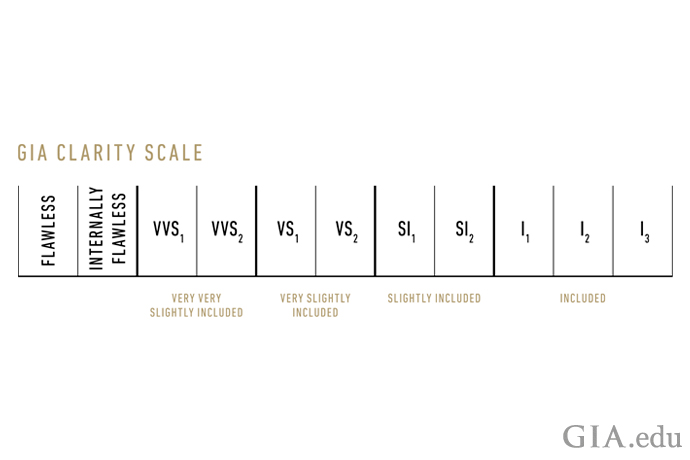
The GIA Diamond Clarity Scale has 11 grades, which range from Flawless to I3.

This 2.78 ct D-color round brilliant cut diamond is Internally Flawless. Photo: Robert Weldon/GIA. Courtesy: Rogel & Co. Inc.
Here are two other terms you might come across.
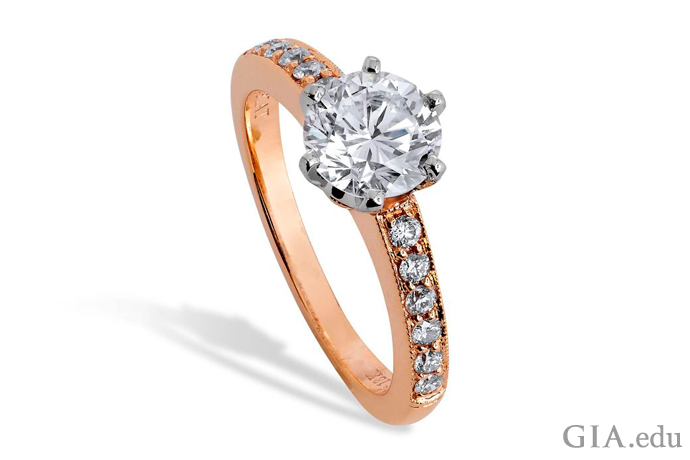
The beauty of this 1.40 ct F color, SI1 clarity round brilliant cut diamond is undeniable. The six-prong platinum basket and 0.20 carats of diamond melee in an 18K rose gold shank add extra charm. Courtesy: 1stdibs.com
Just as GIA developed the globally recognized terms for grading diamond clarity, it also developed the processes for objective and unbiased diamond clarity grading . GIA procedures include viewing a diamond under controlled lighting conditions, using specific viewing angles and distances, and following precise steps that ensure every part of the diamond is examined to locate all the inclusions and blemishes that might affect its clarity.
A GIA diamond grader examines the diamond using her trained eye, a 10× jeweler’s loupe and sometimes a microscope at increased magnification. However, the final clarity grade is always determined by the diamond’s appearance under a 10× jeweler’s loupe.
In arriving at a clarity grade, the grader takes into account five factors:
A diamond may have many tiny inclusions and still be high on the clarity scale. Ultimately, it’s the combination of these five factors that affects the overall clarity appearance. Blemishes, in contrast, can often be removed when a diamond is polished or repolished, so they rarely have an effect on grades lower than IF.

The 10.21 ct emerald cut diamond featured in this engagement ring received a diamond clarity grade of VS2. Courtesy: TrueFacet.com
Manufacturers sometimes try to improve diamond clarity to make stones more attractive and more valuable. Here are two common methods used to accomplish this.

As seen here with 30× magnification, a thin channel has been laser drilled from the surface of the diamond to a large inclusion that was then vaporized or dissolved. Photo: Vincent Cracco/GIA
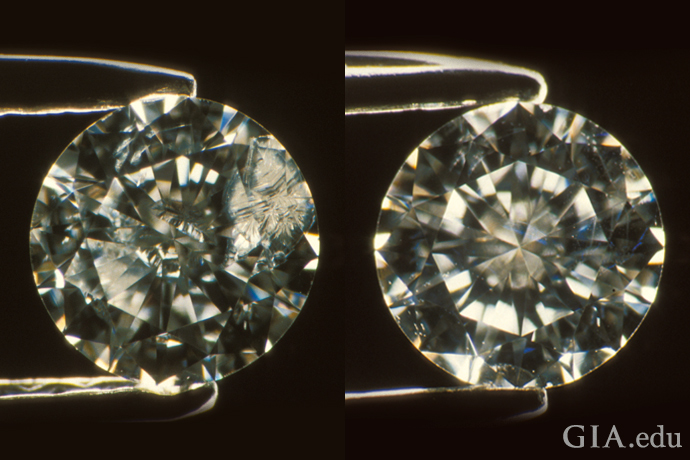
A 0.20 ct diamond with large, highly visible reflective fractures is shown here before (left) and after (right) filling with a glass-like substance. Photos: Shane F. McClure/GIA
Generally, if a diamond has significant durability problems, it doesn’t survive the friction and pressure of the cutting process. However, certain types of inclusions, especially if they’re near the girdle – the narrow section that separates the diamond’s upper (crown) and lower (pavilion) parts and functions as its setting edge – can make a cut diamond more vulnerable to damage. For example, if the stone is hit precisely on a feather or other surface-reaching inclusion, it might chip. Likewise, very deep feathers that extend from the crown to the pavilion, or that penetrate about one-third of the way or more into the diamond, could pose durability concerns.

The GIA Diamond Grading Report for diamonds on the D-to-Z color scale features a plotting diagram (bottom center panel), which maps a diamond’s inclusions and blemishes as viewed from the crown (left) and pavilion (right).
The GIA Diamond Grading Report, the GIA Diamond Origin Report and the GIA Diamond Dossier provide an objective, unbiased assessment of diamond clarity along with the other “Cs” of diamond quality.
A GIA Diamond Grading Report and GIA Diamond Origin Report contain a plotting diagram that maps the diamond’s inclusions and blemishes. The diagram shows the diamond’s shape and facet arrangements as seen from two views: the crown and pavilion. Symbols are used to represent the type, location, relative size and sometimes the shape of the clarity characteristics being plotted. In addition to providing details about a diamond’s clarity features and describing the diamond’s clarity, the diagram can also assist in diamond identification. No two diamonds below Flawless and Internally Flawless have exactly the same combination or placement of clarity characteristics.
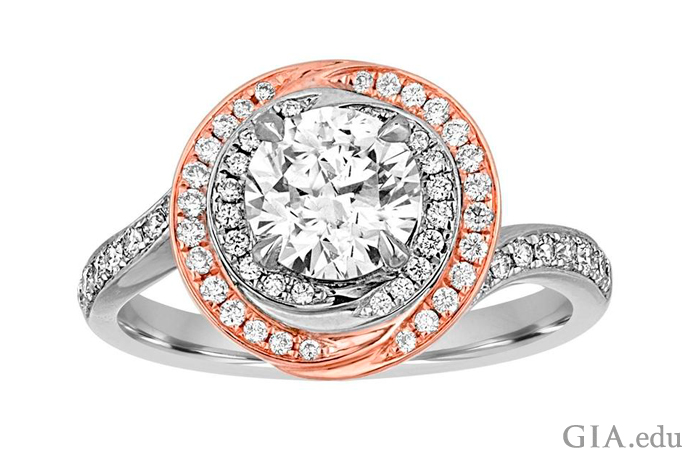
In this engagement ring, a 1.05 ct round brilliant cut diamond is surrounded by a double halo of diamond melee in an 18K white and rose gold setting. The many facets of a brilliant cut diamond make inclusions less visible than they would be in some other cuts, such as the emerald cut. Courtesy: 1stdibs.com
Now that you’ve brushed up on some diamond clarity essentials and know what color and clarity grades are good for your diamond, you just might be wondering: What’s the most important C of diamond quality?
A yellow diamond engagement ring is a stunning choice to celebrate your love. But picking the perfect engagement ring requires knowing about yellow diamonds, mountings, the effect of metals on appearance, treatments and more. We offer help.
Here are a few things you’ll need to know:
A fancy-color yellow diamond falls outside the GIA D-to-Z color range
GIA assigns one of six “fancy” color grades to your yellow diamond engagement ring
Don’t expect a round diamond for your yellow diamond engagement ring
Mountings can make a yellow diamond look darker
The metal used affects the appearance of a yellow diamond engagement ring
Some yellow diamonds might be treated, lab grown or both
Make sure GIA grades the diamond in your yellow diamond engagement ring
A yellow diamond engagement ring is rare because yellow diamonds are rare
Understanding diamond color is essential before you go shopping for a yellow diamond engagement ring. Most colorless or near-colorless gem-quality diamonds are graded based on the absence of color, using GIA’s D-to-Z diamond color-grading system. Yellow diamonds are considered to be colored diamonds and are graded as “fancy” when they have more color than the Z masterstone.
Here is another important difference between yellow diamonds and colorless diamonds. Diamonds in the D-to-Z range usually decrease in value as the color becomes more obvious. The opposite happens with fancy-color diamonds. Their value generally increases with the strength and purity of the color.
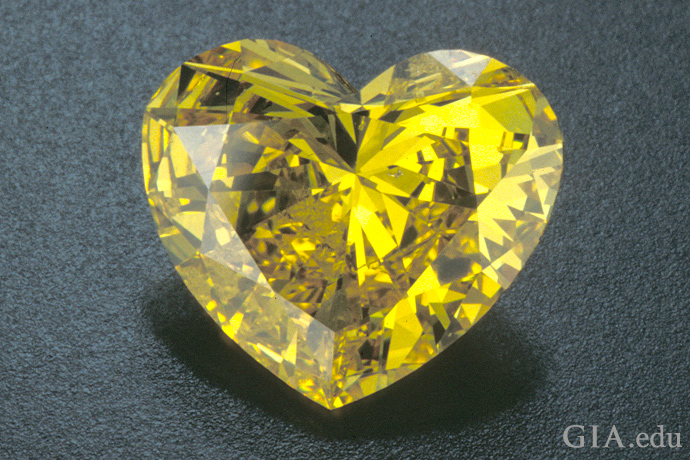
Colored diamonds graded Fancy Intense are often prized over those with other fancy grades. This yellow heart shaped diamond speaks of the first blush of love. Photo: Robert Weldon/GIA

Fancy-color diamonds are often cut into fancy shapes, like a pear shape, to bring out the color. Sunny days lie ahead for the bride wearing this 5.33 carat (ct) Fancy Yellow pear shaped diamond. Courtesy: 1stdibs.com
The names used to describe colors are often quite subjective. Consider that the color yellow includes variations like butter, lemon, golden and more. To bring objectivity and standardization to the grading of the rare beauties that are colored diamonds, GIA created the GIA Colored Diamond Color Grading System in the 1950s and refined it over the decades. This grading system not only defined the processes for determining a diamond’s color, but it also established the terms, or color grades, for describing it.
GIA’s grading system places most colored diamond in one of nine categories based on the diamond’s hue, tone and saturation: Faint, Very Light, Light, Fancy Light, Fancy, Fancy Intense, Fancy Dark, Fancy Deep and Fancy Vivid. The first three grades aren’t used for yellow diamonds, so the scale for yellow begins with Fancy Light. The majority of yellow diamonds in the jewelry industry are graded Fancy Light, Fancy, Fancy Intense and Fancy Vivid.
In general, the more color a colored diamond has, the better. Fancy Deep and Fancy Vivid diamonds, for example, have more color than Fancy Light diamonds—and are usually more valuable. However, tone (the degree of darkness or lightness of a color) is also important. For example, a diamond that is extremely dark (Fancy Dark) may be less desirable than a lighter stone graded Fancy Intense.
It is not unusual for a yellow diamond to have a hue modifier, such as orangy yellow or greenish yellow. A modifier does not indicate that the color is any less strong or pure.

This chart shows the subtle transitions in GIA’s color grading of yellow diamonds. Note, too, that the fancy grades represent a range of color sensations, not a “single” color sensation. Photo: Elizabeth Schrader and C. D. Mengason/GIA
Round diamonds cut in the brilliant faceting style are the most popular diamonds for engagement rings, but you may have a challenging time finding a round stone for your yellow diamond engagement ring. That’s because yellow diamonds typically display a more intense face-up color appearance when they’re cut in a shape other than round. These non-round shapes are called fancy shapes, which include oval, pear, marquise and heart, plus square or rectangular cuts like princess, radiant and emerald.

This 10.12 ct Fancy Vivid yellow pear shape is an example of a fancy-shape diamond. This shape was most likely selected to intensify the yellow color. Photo: Elizabeth Schrader/GIA. Courtesy: The Scarselli Family
If your heart is set on a yellow diamond engagement ring, you will probably look at a number of loose yellow diamonds. Be aware that the yellow diamond that has caught your eye may appear darker when set in a mounting.
Look at the photos below. The diamond on the left in the top image was graded Y–Z range, just on the light yellow/Fancy Light yellow boundary. It is shown next to a Fancy yellow reference diamond. In the bottom image, the larger diamond is mounted in a ring and placed next to the same reference diamond.
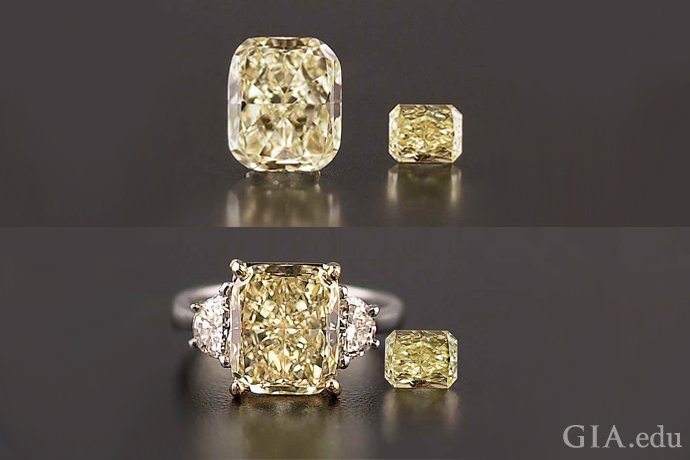
A yellow diamond is likely to look darker once it’s set in a mounting. Photos: Elizabeth Schrader/GIA. Courtesy: The Scarselli Family
This effect can actually work to your advantage, particularly if you’re deciding between a less expensive “light yellow” diamond at the very low end of the D-to-Z color scale and a more expensive Fancy yellow diamond.
Diamonds are highly reflective. Their facets are like tiny mirrors, reflecting their surroundings, which include the color of the ring and the prongs holding the gem. Because of this, the color of the metal will affect a diamond’s appearance.
You’ll typically have three choices when picking a metal for your yellow diamond engagement ring:
Do you want your engagement ring to highlight the color of the yellow diamond? White metals and rose gold will create contrast between the mounting and the stone. White gold makes for a streamlined, sophisticated look. A rose gold mounting will create a warmer contrast.
Do you want your ring to complement the color of the diamond? A yellow gold mounting will harmonize with a yellow diamond. Take a look at Art Deco style engagement rings, Retro style engagement rings and ring styles typical of the Victorian era, times when yellow gold was in fashion, to see if these are designs you’d like to recreate for your yellow diamond engagement ring.
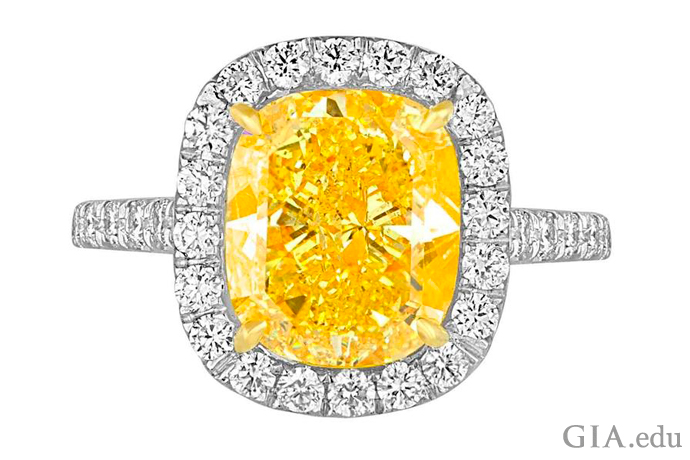
Want your yellow diamond to pop? Set it in a white metal ring. This 4.76 ct Fancy Vivid yellow diamond is so bright that it appears to have captured a ray of the sun. A halo of colorless diamonds surrounds it. Courtesy: 1stdibs.com

Rose gold is another way to create contrast with a yellow diamond. In this ring, it acts as a subtle counterpoint to the 3.46 ct yellow oval diamond. Courtesy: 1stdibs.com
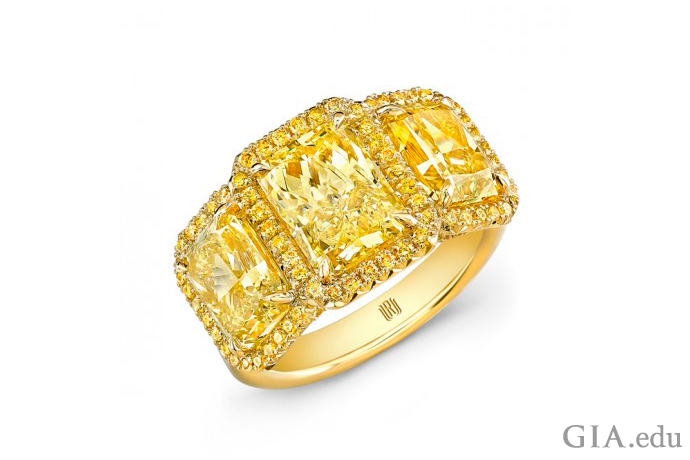
A yellow gold band paired with yellow diamonds creates a harmonious look. The three yellow diamonds set in 18K yellow gold are sure to soothe the eye as they captivate it. Courtesy: Rahaminov Diamonds
Off-color diamonds that are brownish or yellowish can be treated to modify their color. Manufacturers typically use one or both of two different processes:
In both cases, the treatment is considered permanent under normal conditions of wear and care. Non-permanent treatments, like coatings, are also possible. All else being equal, diamonds that have not been treated are more expensive than diamonds that have been treated. Legally, the seller must disclose any treatments. GIA can detect these treatments, and it identifies them in the GIA Colored Diamond Grading Report. It also laser inscribes “HPHT PROCESSED” or “IRRADIATED” on the girdle of diamonds treated by either of these methods.

This 22.27 ct Fancy Vivid yellow emerald cut diamond was identified as artificially irradiated and annealed. Treated diamonds of this size and this attractively saturated color are rare. Photo: Sood OIl (Judy) Chia/GIA
Synthetic yellow diamonds – with properties that match their natural counterparts – are also being manufactured. The first synthetic diamonds were grown by HPHT processes that mimic the high-pressure, high-temperature conditions of natural diamond formation in the earth. Today, chemical vapor deposition (CVD) is another common method whereby synthetic diamonds are grown in an apparatus that uses high temperatures and low pressures in a vacuum chamber. The CVD process involves heating a mixture of a hydrocarbon gas (such as methane) and hydrogen, which releases carbon atoms that then settle onto the cooler, typically square-shaped seed plate of natural or, more likely, synthetic diamond. With both techniques, subsequent treatments may be used to change the color of the original crystal.
GIA can detect synthetic diamonds grown using either HPHT or CVD, and it issues distinctive reports for these synthetic or lab-grown diamonds. The GIA Synthetic Colored Diamond Grading Report offers the same information as the GIA Colored Diamond Grading Report issued for a natural diamond (see below), but it provides a more general description of the color and clarity. For additional disclosure and identification, GIA laser inscribes the diamond’s girdle with the stone’s unique report number and a statement that it is laboratory grown. The report itself looks markedly different from those issued for natural diamonds.

This 0.40 ct square-shaped diamond was grown using the CVD process. Photo: Sood OIl (Judy) Chia/GIA
A yellow diamond engagement ring is a symbol of your love. It’s also a significant emotional and financial investment. So you’ll want to make sure the diamond is graded by a trusted, unbiased lab like GIA. GIA’s meticulous grading process involves testing to determine whether the diamond is natural or lab grown and to identify any known treatments used to enhance its appearance.
Highly trained colored-diamond graders observe the diamond face-up using controlled lighting in a specially designed viewing box that eliminates distractions and shields the stone from external light. These specialists determine the diamond’s characteristic color based on a combination of its size, shape, faceting arrangement and color. They then bracket the diamond using side-by-side comparisons under the same lighting conditions with two or more color references. On the basis of these comparisons, they select one of 27 hues (such as orangy yellow, yellow or greenish yellow) and assign a specific “fancy” grade based on the hue’s tone and saturation.
A GIA Colored Diamond Grading Report provides a full quality assessment of a colored diamond including the color grade, color origin (natural or treated), carat weight, clarity and a plotting diagram of its clarity characteristics. As an optional service, a full-color image of the diamond may also be included.

A GIA Colored Diamond Grading Report is your assurance that your yellow diamond is a natural diamond, graded to GIA’s exacting standards. It also provides full disclosure of any known treatments discovered during the grading process. Photo: GIA

If you’re looking for a unique engagement ring, this 2.03 ct Fancy Vivid yellow cushion cut diamond set in platinum will surely stand out. Courtesy: EraGem.com
When you wear a yellow diamond engagement ring, you’ll have something unusual on your finger. In the early 2000s, for example, yellow diamonds represented only 2.4% of all diamonds submitted to GIA for various grading reports over the course of a single year. If unearthing a diamond is noteworthy, then discovering a yellow diamond is like finding a golden needle in a haystack.
Still yearning for a yellow diamond engagement ring? Dig a little deeper to learn more about yellow diamonds.
Use of this site signifies your agreement to its terms of use.
© 2002 – 2024 Gemological Institute of America Inc. GIA is a nonprofit 501(c)(3) organization.
All rights reserved.